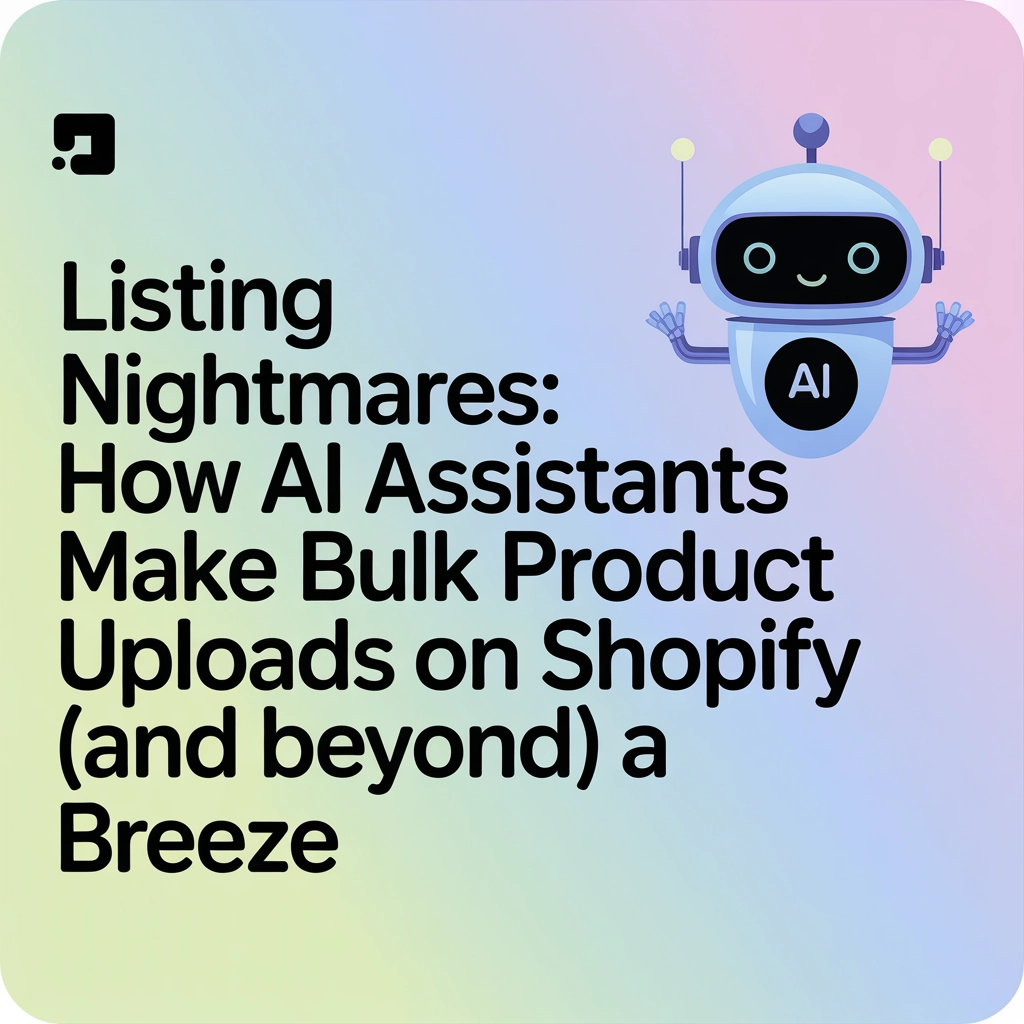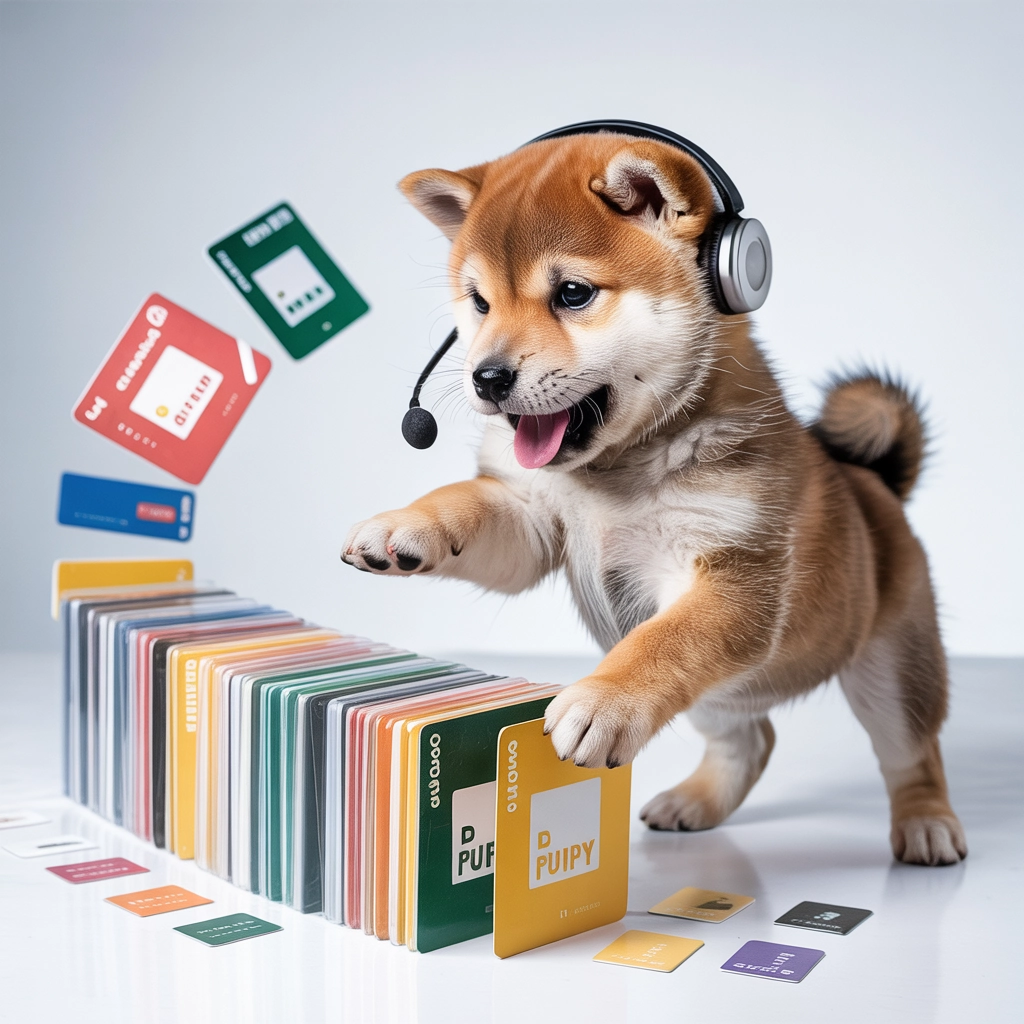Listing Nightmares: How AI Assistants Make Bulk Product Uploads on Shopify (and Beyond) a Breeze
Transform your e-commerce product listing process from a 50-hour nightmare into a 2-hour breeze with AI-powered automation tools.

 🐾
🐾Listing Nightmares: How AI Assistants Make Bulk Product Uploads on Shopify (and Beyond) a Breeze

You've finally sourced those perfect 200 products for your store. The excitement quickly fades as reality sets in: each one needs a compelling title, detailed description, proper categorization, variant setup, and SEO optimization. Oh, and you need them live by tomorrow.
Sound familiar? For small business owners, the product listing bottleneck isn't just frustrating—it's a genuine growth barrier that can turn your e-commerce dreams into an administrative nightmare.
The Product Listing Time Trap
Let's crunch some sobering numbers: The average product listing takes 15-30 minutes to create manually when done properly. For a modest catalog of 100 products, that's:
- 25-50 hours of pure data entry
- Countless opportunities for inconsistency
- A high likelihood of burnout
- Delayed launches that cost you sales
As Sara, a jewelry store owner, told us: "I used to spend entire weekends just writing descriptions. Some weeks I'd choose between updating inventory or spending time with my family—it was that bad."
Enter the AI Product Listing Assistant
What if you could turn those 50 hours into just two? That's the reality AI assistants are creating for e-commerce entrepreneurs today.
AI product listing tools have evolved far beyond simple text generators. Today's solutions understand product contexts, extract data from images, optimize for conversion, and handle bulk operations across multiple platforms simultaneously.

The Magic Behind AI-Powered Listing Creation
1. Intelligent Data Extraction
Modern AI doesn't just generate content—it gathers it. When you point an AI assistant at a supplier's website, product images, or even just basic specifications, it can:
- Extract technical details from product images
- Identify materials, dimensions, and features
- Recognize color variations and styles
- Pull pricing information from supplier sites
This means you can often start with nothing more than a spreadsheet of supplier SKUs or a folder of product images, and your AI assistant does the detective work.
2. Compelling Content Generation
The days of generic, templated product descriptions are over. Today's AI tools create unique, on-brand content for each product by:
- Adapting to your brand voice and style guidelines
- Highlighting unique selling points for each item
- Creating benefit-focused descriptions that convert
- Generating technical specifications in readable formats
"It's like having a product copywriter who knows your brand inside and out, works 24/7, and never asks for a raise," explains Michael, who runs a home goods store with over 1,500 SKUs.
3. Bulk Operations That Actually Work
The real game-changer is how these AI assistants handle scale. When working with hundreds or thousands of products, you can:
- Upload entire catalogs with a single operation
- Apply consistent formatting and branding across all listings
- Make bulk updates when pricing or availability changes
- Clone and modify listings for similar products
The result? What used to take weeks happens in hours—or even minutes.

Real-World Transformation: 4 Tasks AI Makes Painless
Task 1: Creating Variant-Rich Products
Before AI: Setting up a t-shirt with 5 colors, 6 sizes, and 3 fabrics meant manually creating 90 variants, each needing inventory tracking, images, and pricing.
With AI: Upload one primary product image and basic details. Your AI assistant generates all variants, creates combination-specific descriptions, and even suggests appropriate pricing based on material costs.
"Our clothing store launched 300 new summer products in two days—something
that would have taken us three weeks before. The AI handled all the size/color
combinations and even wrote different descriptions highlighting the benefits
of each fabric type."
- Jamie, Fashion Boutique Owner
Task 2: Cross-Platform Consistency
Before AI: Listing products on Shopify, Amazon, and Etsy meant creating three separate listings with platform-specific formats, requirements, and optimization strategies.
With AI: Create one master listing, and the AI adapts it to each platform's specific requirements, character limits, and best practices—while maintaining your brand voice across all channels.
Task 3: Bulk Image Processing
Before AI: Manually cropping, resizing, and optimizing product images for web use, then uploading them one by one.
With AI: Bulk upload raw product photos, and AI tools automatically:
- Remove backgrounds if needed
- Optimize image quality and file size
- Create multi-angle composites
- Generate alt text for accessibility and SEO
- Link images to the correct products and variants
Task 4: Ongoing Catalog Management
Before AI: Price updates, inventory synchronization, and seasonal description changes required tedious spreadsheet manipulation and manual updates.
With AI: Make changes to a master product list, and your AI assistant propagates those changes across your entire catalog, updating descriptions, tags, and collections to match new information.

Beyond Shopify: Multi-Platform Magic
While Shopify is a leading e-commerce platform, today's small businesses rarely operate on a single channel. Modern AI assistants extend their capabilities to:
- Amazon listings - Adapting content to Amazon's A+ content standards
- Etsy shops - Optimizing for Etsy's unique search algorithms
- WooCommerce sites - Syncing with WordPress-based stores
- Social selling - Creating shoppable posts for Instagram and Facebook
- B2B platforms - Generating wholesale-appropriate product content
The key advantage? Create once, publish everywhere—with platform-specific optimizations handled automatically.
Getting Started: Your First AI-Powered Upload
Ready to transform your product listing process? Here's a simple roadmap:
-
Organize your base product data - Create a spreadsheet with basic details (SKUs, names, prices, categories)
-
Gather visual assets - Collect product images, even if they're not perfectly processed
-
Define your brand guidelines - Provide examples of your preferred tone, key selling points, and customer pain points
-
Choose your AI assistant - Look for solutions that integrate directly with your e-commerce platform
-
Start with a test batch - Upload 10-20 products and refine the process
-
Scale with confidence - Once you're happy with the results, process your entire catalog
Most businesses see 75-90% of the work handled automatically, with minimal human review needed for the final listings.
The ROI of AI-Powered Product Listings
Let's talk bottom line. What's the actual return on investing in AI listing tools?
- Time savings: 80-95% reduction in listing creation time
- Consistency: Uniform quality across your entire catalog
- SEO benefits: Optimized listings that rank better in search
- Conversion improvements: Professional descriptions that sell
- Scaling capacity: Ability to handle 10x more products with the same team
For small businesses, this often translates to:
- Getting products to market 3-4x faster
- Ability to refresh descriptions seasonally
- More time focused on product sourcing and marketing
- Reduced stress and administrative burden
Real Business Impact: Maya's Story
Maya runs a home decor dropshipping business that sources products from multiple suppliers. Before implementing AI listing tools, she managed about 200 products and spent 15+ hours weekly on listing maintenance.
After implementing an AI assistant for her product catalog:
- Her store grew to 850+ products with no additional staff
- Product listing time dropped from days to hours
- Description quality improved, boosting conversion rates by 22%
- She launched a second niche store using the time she saved
"The AI doesn't just save time—it creates better listings than I could write myself," Maya explains. "It researches competitive products, understands what makes each item special, and writes descriptions that actually address customer questions."
The Future of AI Product Management
As impressive as today's tools are, we're just scratching the surface. Soon, AI assistants will:
- Automatically suggest new products based on your sales patterns
- Create product bundles with optimized pricing
- Generate lifestyle imagery using generative AI
- Predict inventory needs based on seasonal trends
- Write multilingual listings for global expansion
The end goal? A world where small business owners focus entirely on product selection and customer experience, while AI handles the administrative burden of getting those products online and optimized for sales.
Ready to transform your product listing workflow? Your AI assistant is waiting to take that spreadsheet nightmare off your hands—and turn it into a catalog of opportunity.
Tailforce's AI assistants can help automate your product management workflow, whether you're dealing with 10 products or 10,000. Want to see how much time you could save? Try our product listing automation tool today and get your first 50 listings processed for free.
 🐾
🐾